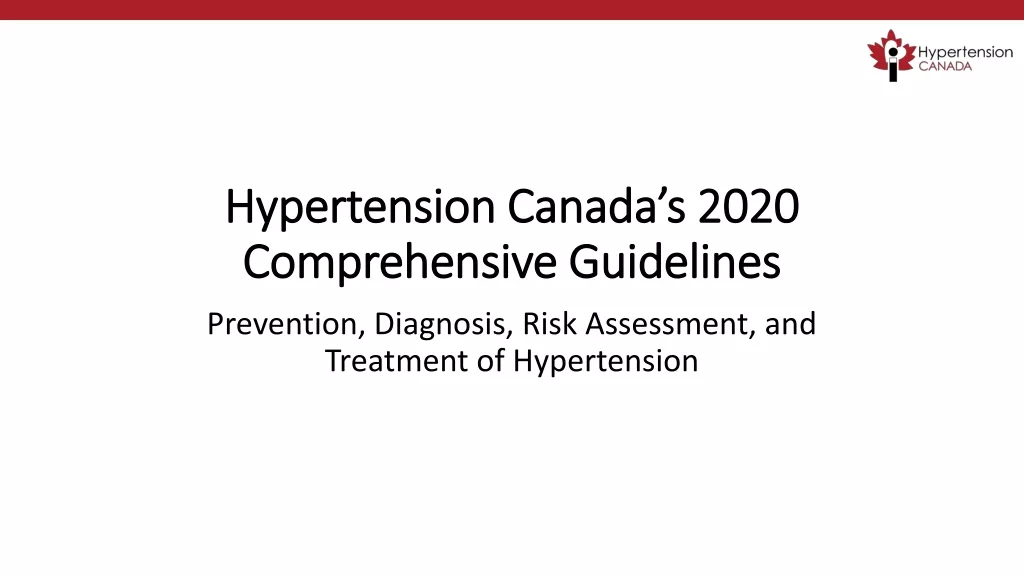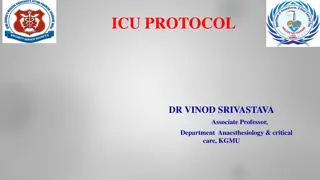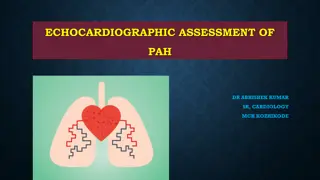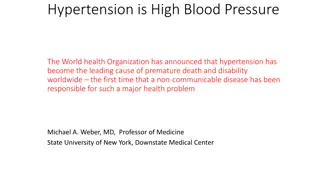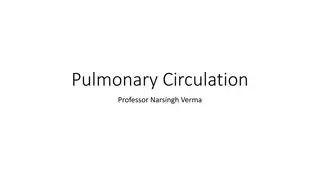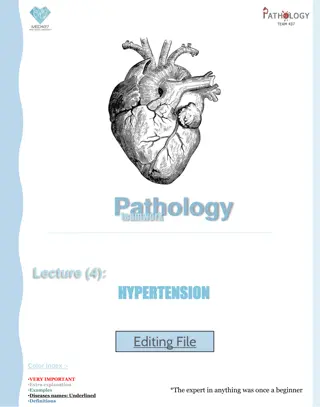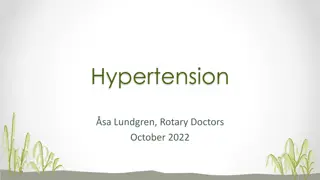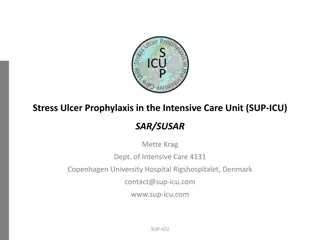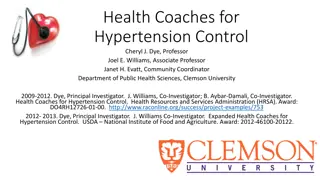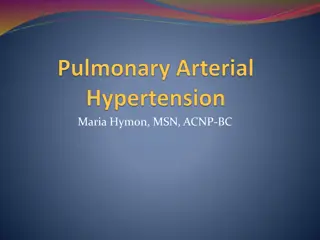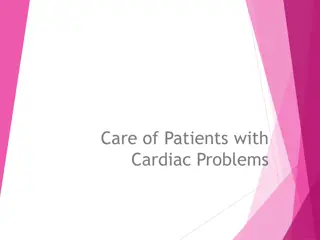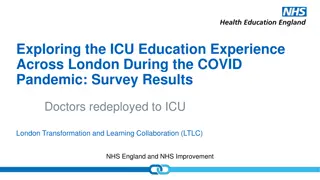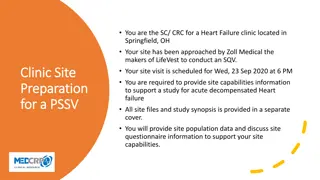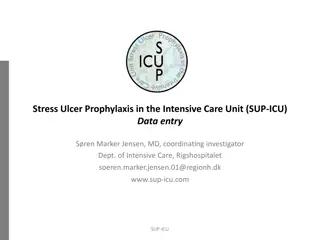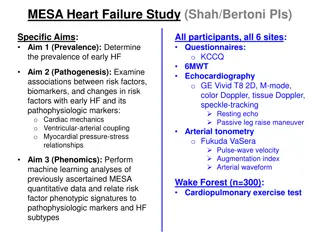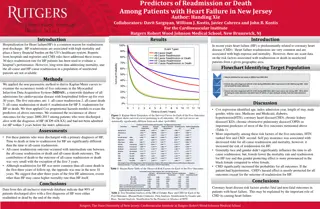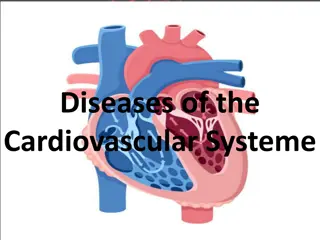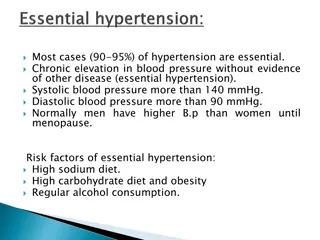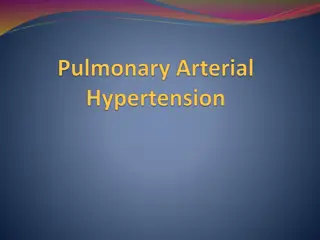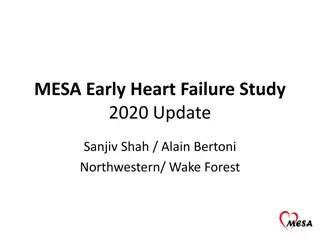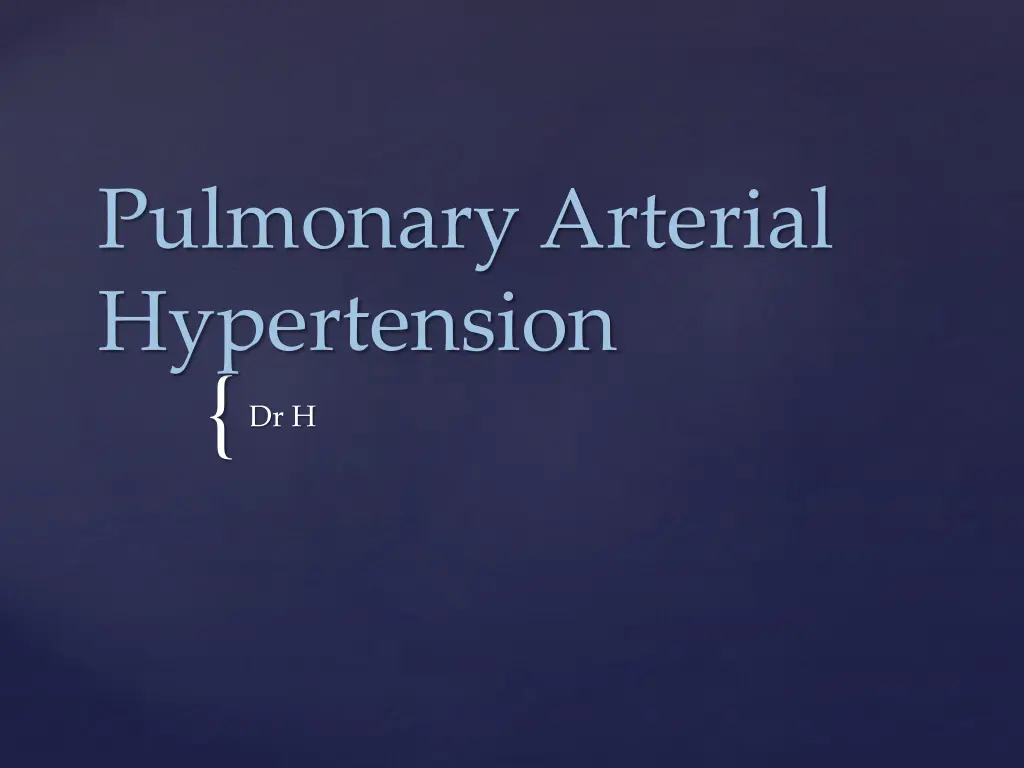
Understanding Pulmonary Arterial Hypertension: Pathophysiology, Epidemiology & Clinical Manifestations
Explore the pathophysiology, epidemiology, and clinical features of Pulmonary Arterial Hypertension (PAH), including abnormal elevation in pulmonary artery pressure, systemic sclerosis, and common associated conditions like sickle cell disease. Learn about the physiological changes, diagnostic tools, and manifestations of PAH to enhance your knowledge in managing this condition effectively.
Download Presentation

Please find below an Image/Link to download the presentation.
The content on the website is provided AS IS for your information and personal use only. It may not be sold, licensed, or shared on other websites without obtaining consent from the author. If you encounter any issues during the download, it is possible that the publisher has removed the file from their server.
You are allowed to download the files provided on this website for personal or commercial use, subject to the condition that they are used lawfully. All files are the property of their respective owners.
The content on the website is provided AS IS for your information and personal use only. It may not be sold, licensed, or shared on other websites without obtaining consent from the author.
E N D
Presentation Transcript
Pulmonary Arterial Hypertension { Dr H
Overview of the pathophysiology of PHTN Literature discussion of outpatient treatment of PHTN Review of important concepts of right heart failure in the ICU setting Objectives
Abnormal Elevation in Pulmonary Artery Pressure Feature of Advanced Disease (in the etiologic process) RV Failure is Associated with a Poor Outcome True Idiopathic PAH is rare Worldwide, schistosomiasis is the commonest cause (ova embolize from liver and cause an inflam rxn and resulting chronic changes). Group 1.4.5 Anorexigans are the commonest drug class associated with PAH. Group 1.3 PAH Pearls
15-50 cases/million Systemic Sclerosis 7-12% Sickle Cell 2-3.75% HIV 0.5% Epidemiology Badesch DB, Raskob GE, Elliott CG, et al. Pulmonary arterial hypertension: baseline characteristics from the REVEAL Registry. Chest 2010;137:376 87.
Epidemiology Age-Standardized Death Rates of Pulmonary Hypertension as Any Cause of Death Among All Ages by State, 2010
Increased resistance in pulmonary circulation Increased RV pressure (to preserve CO) Pulmonary vasculature remodels (medial hypertrophy, eccentric/concentric intimal fibrosis, fibrous webs, plexiform lesions) Sustained pulmonary hypertension Pathophysiology
Exertional dyspnea Fatigue Angina (RV ischemia) Near-syncope or Syncope Peripheral edema Features (related to progressive right ventricular dysfunction)
JVP Carotid impulse Palpable RV impulse P2 +S4 (on right side) TR (pansystolic murmur) Peripheral cyanosis/edema (late findings) Physical Exam
CXR Enlarged central pulm arteries ECHO RV & RA enlargement TR (jet can estimate RV systolic pressure) EKG RAD and RV hypertrophy ABG Hypoxemia, abnl DLCO, poss Hypercapnea TSH Frequently abnl in pts, should be evaluated periodically Studies
1. Pulmonary arterial hypertension 1.1 Idiopathic PAH 1.2 Heritable PAH 1.2.1 BMPR2 1.2.2 ALK-1, ENG, SMAD9, CAV1, KCNK31.2.3 Unknown 1.3 Drug and toxin induced 1.4 Associated with: 1.4.1 Connective tissue disease 1.4.2 HIV infection 1.4.3 Portal hypertension 1.4.4 Congenital heart diseases 1.4.5 Schistosomiasis1 Pulmonary veno-occlusive disease and/or pulmonary capillary hemangiomatosis1 . Persistent pulmonary hypertension of the newborn (PPHN) 2. Pulmonary hypertension due to left heart disease 2.1 Left ventricular systolic dysfunction 2.2 Left ventricular diastolic dysfunction 2.3 Valvular disease 2.4 Congenital/acquired left heart inflow/outflow tract obstruction and congenital cardiomyopathies 3. Pulmonary hypertension due to lung diseases and/or hypoxia 3.1 Chronic obstructive pulmonary disease 3.2 Interstitial lung disease 3.3 Other pulmonary diseases with mixed restrictive and obstructive pattern 3.4 Sleep-disordered breathing 3.5 Alveolar hypoventilation disorders 3.6 Chronic exposure to high altitude 3.7 Developmental lung diseases 4. Chronic thromboembolic pulmonary hypertension (CTEPH) 5. Pulmonary hypertension with unclear multifactorial mechanisms 5.1 Hematologic disorders: chronic hemolytic anemia, myeloproliferative disorders, splenectomy 5.2 Systemic disorders: sarcoidosis, pulmonary histiocytosis, lymphangioleiomyomatosis 5.3 Metabolic disorders: glycogen storage disease, Gaucher disease, thyroid disorders 5.4 Others: tumoral obstruction, fibrosing mediastinitis, chronic renal failure, segmental PH Table 1 Updated Classification of Pulmonary Hypertension 5th WSPH Nice 2013. BMPR = bone morphogenic protein receptor type II; CAV1= caveolin-1; ENG = endoglin. Classification J Am Coll Cardiol. 2013;62(25_S):. doi:10.1016/j.jacc.2013.10.029
Collagen Vascular Disease (Group 1.4.1) CREST & Scleroderma SLE, Sj gren s, Dermato&Poly-myositis, RA IPF common component Etiologies
Lung Disease & Hypoxia (Group 3) Under hypoxic conditions: pulm vasc constricts Membrane sulfhydryl redox status changes Ca increases and potassium currents are inh (i.e. depolarization of the pulm sm-muscle is inh) Pulmonary vasculature remodels NO, endothelin 1/GF/AGII Usually PAP <50mmHg Polycythemia common COPD treat with O2 ILD treat ILD (PAH tx can worsen ILD) OSA treat as coexisting disease Chest Wall Disorders Etiologies
Thromboembolic Disease (Group 4) ~rare cases of infiltrate other than clot Impaired fibrinolytic resolution Incomplete recanalization Chronic obstruction Chronic: May attempt thromboendarterectomy (mortality is 12%, in specialized centers this is decreasing to 1% with >90% efficacy). Riociguat RCT 443 pts (2.5mgTID) improves symptoms & exercise tolerance, as well as time to worsening sGC to NO (may also be antiproliferative) Soluble guanylate cyclase (don t use with PDE-5i) Definitely warfarin. No thrombolytics Etiologies
Other Idiopathic (1.1) 2cases/mil, female 4th/5th decade HIV (1.4.2) 0.5% risk traditional PAH treatment, treating underlying disease not helpful Portal Hypertension (1.4.3) May try traditional treatment Congenital Shunts (1.4.4) Post-tricuspid (VSD or PDA) Sickle Cell (Group 5) treat underlying disease Sarcoidosis (Group 5) if pulm vasc involved, traditional treatment works well Etiologies
Heterozygous BMPR2 mutation (Group 1.2.1) 75% of familial PAH Up to 25% of sporadic PAH Encodes vascular proliferation Others: BMPR1B and SMAD9 (Group 1.2.2) Genetics
Echo (screening modality only) ESC Pulmonary Hypertension Review 2015
Accurately measures PAP, CO, LV filling pressure PAP>25mmHg PCWP (or LVEDP) <15mmHg PVR >3WU Exclude cardiac shunt Pulmonary vasodilator reactivity testing Responder: PAP >10mmHg (to <40mmHg without a decrease in CO) NO, adenosine, or epoprostenol Responders can be treated with CCB Responders have a favorable prognosis Cardiac Catheterization
Risk Assessment ESC Pulmonary Hypertension Review 2015
Idiopathic Drug-induced Hereditary HIV (include HAART) Consideration in CTD Consider in PoPHTN
Humbert et al. Advances in Therapeutic Interventions for Patients with Pulmonary Arterial Hypertension. Circulation. 2014
High Dose Nifedipine 240mg/d Amlodipine 20mg/d Decrease Pressures Improve symptoms Survival >20yrs Less than 20% of pts respond to CCB Not FDA approved 92 study demonstrated 95%5yr surv in responders CCB Rich S, Kaufmann E, Levy PS. The effect of high doses of calcium-channel blockers on survival in primary pulmonary hypertension N Engl J Med 1992;327:76-8
Bosentan Initiate at 62.5mg BID x 1 month 125mg BID thereafter NYHA Class III/IV Double-blind, placebo-controlled study of 213 pts Improves symptoms & exercise tolerance Used in scleroderma pts (first study) Monitor LFTs Do not use if pt on cyclosporine or glyburide Endothelin Receptor Antagonists Rubin LJ, Badesch DB, Barst RJ, et al. Bosentan therapy for pulmonary arterial hypertension N Engl J Med 2002;346:896-903
Macitentan 3 to 10mg NYHA Class III/IV Double-blind, placebo- controlled study of 742 patients Improve symptoms & exercise tolerance but also MORTALITY BENEFIT Endothelin Receptor Antagonists Pulido et al. Macitentan and morbidity and mortality in pulmonary arterial hypertension. NEJM 2013
Sildenafil 20mg TID NYHA Class II&III Randomized, double-blind, placebo-controlled trial of 278 pts Improves symptoms and exercise tolerance Do not use if pt on nitrates Tadalafil is qd, Vardenafil is BID Phosphodiesterase-5 Inhibitors Galie N, Ghofrani HA, Torbicki A, et al. Sildenafil citrate therapy for pulmonary arterial hypertension N Engl J Med 2005;353:2148-2157
Iloprost 2.5/5mcg/inh q2h NYHA III/IV imp sym & e.t. Epoprostenol CVC infusion pump (?25-40ng/kg/min) Half-life 3-5 minutes Open-label, randomized tril of 81 pts (results reproducible in two further trials) NYHA III/IV imp sym, e.t., & survival Decreases mortality ~70% Treprostinil IV/SQ infusion pump (?50-100 ng/kg/min) NYHA II-IV imp symp, e.t Prostacyclins vasodilate, Plt Inh, Inh of vascular smooth-muscle growth, +inotropy Barst RJ, Rubin LJ, Long WA, et al. A comparison of continuous intravenous epoprostenol (prostacyclin) with conventional therapy for primary pulmonary hypertension. The Primary Pulmonary Hypertension Study Group. N Engl J Med 1996;334:296-302
Selexipag RCT of 1156 patients Maximum dose 1600mcg BID 39% reduction in composite morbidity/mortality I would not state this has a survival benefit Prostacyclin IP Receptor Agonist McLaughlin et al. Effect of selexipag on morbidity/mortality in pulmonary arterial hypertension: results of the GRIPHON study. J Am Coll Cardiol 2015
Riociguat RCT of 443 patients Maximum dose of 2.5mg TID Improved exercise capacity and time to worsening Used in inoperable CTEPH Guanylate Cyclase Stimulator Ghofrani et al. Riociguat for the Treatment of Pulmonary Arterial Hypertension. NEJM 2013
Combination Improved 6MWT, pt satisfaction, and reduction in NTproBNP Combination Associated With Increased peripheral edema, headache, nasal congestion, and anemia Combination Therapy Galie et al. Initial use of Ambrisentan plus Tadalafil in Pulmonary Arterial Hypertension. NEJM 2015
Early referral for transplant PoPH pts must have controlled PAP (<35mmHg) Cardiopulmonary Rehab Diuretics Decrease RV overload (if pt with TR) Decrease edema Supplemental O2 If baseline O2 low, supplementation will help alleviate dyspnea and RV ischemia Iron Supplementation Anticoagulation Warfarin, INR goal 2-3xcontrol Avoid in PoPH Other Treatment Pregnancy is HIGH risk I also encourage DNR/DNI status
Differences between the RV and LV Muscle structure is purely longitudinal in contraction In addition, the wall is thin Sustained ejection Coronary blood flow is continuous from the RCA Right Heart Failure in the ICU Poor H., Ventetuolo C. Pulmonary Hypertension in the Intensive Care Unit. Prog Cardiovasc Dis 2012;55:187-198.
Sepsis Cytokine-mediated myocardial depression ARDs-induced pulmonary vascular dysfunction Reduced SVR Pneumonia Shunt inducing increased pulmonary vascular resistance (hypoxic vasoconstriction) Arrhythmia Acute PE Rebound PH (from withdrawal of vasodilators) Anemia Positive-pressure ventilation (collapse of RV) Etiologies of Acute RHF in the Setting of Underlying PHTN
Treat underlying cause Fluid management negative fluid balance with diuretics or hemofiltration Vasopressors low dose dopamine or norepinephrine are favored over neosynephrine, epinephrine, and vasopressin Inotropes dobutamine and milrinone may augment diuretic effect but can induce hypotension Pulmonary Vasodilators inhaled NO will increase CO (20%) and decrease PVR (may need to monitor for methemoglobinemia and to titrate off) Goal O2Sat >90% Goal Hgb >10 VA-ECMO as a bridge (to thromboendarterectomy or transplant) Management of RHF
World Health Organization (WHO) functional class III or IV Mean right atrial pressure >10 mmHg Mean pulmonary arterial pressure >50 mmHg Cardiac index <2.5 L/min per m2 Failure to improve functionally despite medical therapy Rapidly progressive disease Transplant Considerations

